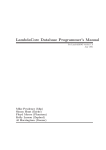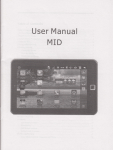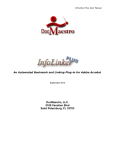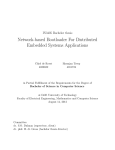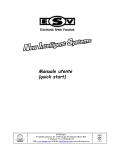Download Nothing relevant. nothing relevant 1
Transcript
Nothing relevant. nothing relevant 1 Undoing Actions in Collaborative Work1 Atul Prakash Michael J. Knister Software Systems Research Laboratory Department of Electrical Engineering and Computer Science University of Michigan, Ann Arbor, MI 48109-2122 Phone: (313) 763-1585 Email: [email protected], [email protected] ABSTRACT changes because the work is not solely theirs. Knowing that any previous state can be easily recovered may free group members to demonstrate ideas in the document. This freedom also applies to asynchronous sharing, where group members work on a shared document at dierent times; tentative changes can be made to the section of a document, and undone at a later time if needed. Performing undo in collaborative applications provides technical challenges three areas: choosing the operation in choosing the action to be undone, determining where the undo should occur, and resolving conicts between dierent users. First, choosing the action to undo in a single-user system is usually easy: simply choose the most recent action and use it to revert to the prior state of the document. However, in a group environment, there are many parallel streams of activity from dierent users, and the undo needs to be more selective about choosing what to undo. Also, a return to a previous global state could have undesirable eects because it would undo actions of all users, instead of just one. Second, once the correct operation is chosen to be undone, the location at which the undo of an action should be performed may be dierent from the location at which the action was originally performed due to the eects of other users' activity on the document. Finally, if two or more users interleave their work in the same portion of a document, it may not make sense to undo one user's changes without undoing the other users' changes. In this case, there are conicts between the changes the users made. The rest of the paper is organized into the following sections: Due to lack of full awareness of other users' intentions, the possibility of inadvertent mistakes is higher in collaborative work, and yet most current collaborative systems fail to provide adequate facilities for undoing actions. This limitationoccurs because undo facilities of single-user systems do not readily apply to collaborative systems. In this paper, we propose a general framework for undoing actions in collaborative software systems. The framework takes into account the possibility of conicts between different users' actions that may prevent a normal undo. The framework also allows selection of actions to undo based on who performed them, where they occurred, or any other appropriate criteria. 1 Introduction The ability to reverse, or undo, the eects of previous actions has become a common feature in modern application software. This ability is particularly valuable in collaborative applications, but it is technically much more dicult to implement than in a single-user system. Numerous collaborative editors and other group applications have been constructed, such as GROVE [Elli90], ShrEdit [CSMIL89,91], and DistEdit [Knis90], but most lack undo capabilities. Those which provide undo generally provide only a global undo, in which the last change made by anyone to a document is undone, rather than allowing users to individually reverse their own changes. Undo is important in collaborative applications because it provides freedom to interact and experiment in a shared workspace. A shared document is often used as a group blackboard during (possibly distributed) meetings. If the current state of the document contains important information, people may have inhibitions about making A review of previous work on undo. A discussion of how our approach extends undo capabilities, particularly for group environments. The requirements an application must meet to use 2 our undo framework, and an example for text editing. The undo algorithms. Several interface possibilities for using the undo algorithms. Other issues relevant to group undo, including replication and the amount of undo state to store. Conclusions and future work. Operations E and D can be undone (in sequence), then a new operation F done, and then D redone, giving the following history list (list of operations done so far): ABCF DE " A pointer is used to keep track of next action to be undone; in this example, the undone operation E would be the next operation which could be redone. Note that undo operations are not explicitly stored in the history list. So, if one wants to back to the original sequence without the F, it is not possible. One could undo F , but then D and E must be done manually. The Undo, Skip, Redo (US&R) model [Vitt84] supports redo like the linear undo model, but also allows a more user-friendly skipping of some operations during the redo. Instead of a linear list, US&R model keeps a tree data structure for maintaining history so that it becomes possible to restore state to any point in the history (unlike the linear undo model). In the above example, F would be stored on a dierent branch of the tree from the sequence D E so that F could be undone and then D and E could be redone if the user so desired. A limitation of both the linear undo model and the US&R model is that in order to undo one operation O several steps back in the history, all subsequent operations must rst be undone and then redone (skipping O during the redo). This is potentially disruptive in a group environment; other users are likely to see their work undone for at least a short while with no apparent reason. Furthermore, if the implementation is not careful, after the redo, other users' context (cursor position, window buer) may change unexpectedly from the original context. Also, neither model addresses the problem of conicts { that redoing some operations may not semantically make sense if an earlier operation is skipped. 2 Related Work There are several basic methods for providing undo abilities in single-user systems. We discuss them here. In our discussion, we assume that the operations that can be performed on a document are reversible, i.e., for every operation A, we can determine an inverse operation A that will undo the eect of A. For instance, in an editor, an INSERT operation can be undone by a DELETE operation. Note that, in general, the inverse operation of A may depend on state of the document prior to A. For instance, if a DELETE operation is done on a text document that deletes three characters at position 10, then in order to determine its inverse, we must know the three characters that were deleted. The inverse operation then will be an INSERT operation that inserts those three characters back at position 10. 2.1 Single-step undo Single-step undo is common in most Macintosh and Windows applications, as well as editors such as vi. It allows undo of the last operation. For instance, given a sequence of operations ABC DE 2.3 History undo Single-step undo allows undoing of operation E, but not a subsequent undo of operation D. Usually redo of last undo is also allowed (often implemented as an undo of the last undo) so that, in the above example, E can be redone. In the history undo scheme, one can undo any number (to some limit) of past actions in a row. The GNU Emacs editor [FSF85] supports history undo. Once a user stops undoing his work (by doing something other than an undo, e.g., inserting a character), the undone actions become like any other actions { they can be subsequently undone if desired. Consider the sequence of operations 2.2 Linear undo model and US&R model The Interlisp system [Teit78], one of the early systems to provide undo, used the linear undo model. The linear ABCDE undo model allows undoing of a sequence of operations and keeps a pointer which tracks the last operation un- Now, suppose E is undone. Then in the history undo, done. Operations can then be redone, after possibly doing the history list will be as follows, where E is the operation some new operations. For instance, suppose that there is that reverses the eects of E: a sequence of operations ABCDEE ABC DE " 3 Notice that a pointer is used to keep track of the next operation to be undone. On another undo, the history list will be as follows: ABCDEED list could be selected based on any other attribute, for instance region, type, time, task, or anything else. Thus, we term our scheme as selective undo, since the operation to be undone is not necessarily the last one, but is selected using some attribute attached to the operation. We would like to undo A2, but without undoing and then redoing B2 and B3 . To selectively undo an operation, we cannot simply execute the inverse of the operation because later operations could have shifted the location where the undo must be performed. For example, suppose the following two text operations have been applied to the starting state `abcd': INSERT(4; x ) followed by INSERT(1; yy ), resulting in the state `yyabcxd'. The rst operation inserted `x' at position 4, and the second operation inserted `yy' at position 1. Assume that these operations were done by dierent users. Now the user who did the rst operation wishes to undo the operation. However, we cannot simply perform the rst operation's inverse, DELETE(4; 1), because the second operation has moved the `x' to location 6. Our scheme takes this possibility of location shifting into account, so that in this example, the rst operation will be undone by executing DELETE(6; 1). We also take into account the possibility of conicts. In the above example, B2 may have modied the same region of the document as A2 , so that it no longer makes sense semantically to undo A2 without rst undoing B2 . We do not allow an operation to be undone until any prior conicting operations have been undone. " If one now breaks out of the undo mode by doing some operation other than an undo, say F, the history list will be: ABCDEEDF " At this point, doing two more undo operations will result in: ABCDEEDF F D 0 " History undo has the nice property that it is possible to go back to any previous state, and the possibility of conicts does not arise (in single-user applications) since operations are never skipped. 3 Our Approach Our approach is similar to history undo, but it allows operations to be undone selectively and deals explicitly with location shifting and conicts. We use data structures similar to those used in history undo; in particular, upon an undo, the inverse of an operation is appended at the end of the history list. In our experience, use of history is simple and intuitive for most users. However, in a collaborative application, since the last operation done by a user may not be globally last (other users may have done operations subsequently), we need to allow undoing of a particular user's last operation from the history list. For example, consider the following history list, where A 's refer to operations done by user A, and B 's refer to operations done by other users: 0 0 0 4 Application Requirements Our undo framework assumes an application model in which all changes to a document are performed using a set of primitive operations. As operations are performed, they are archived in a history list to provide the basis for undo. The operations must be reversible and capable of being re-ordered when no conicts between the operations exist. A1 B1 A2 B2 B3 This section describes in detail the model and requirements our undo framework imposes upon applicaNow, suppose user A wishes to undo his/her last ac- tions. Itwhich also demonstrates tion, A2 . Normal history undo mechanisms in single-user to simple text documents. how the model can be applied systems do not support it because they would require undoing B2 and B3 as well. In the US&R model, it is possible to undo the last three operations and then redo 4.1 Document Model B2 and B3 , but as pointed out in the previous section, that can be disconcerting to other users of the system. In our document model, we assume that applications Note that user A may not be aware that operations B2 modify a document using only a well-dened set of primand B3 have been carried out on the document by other itive operations which are reversible. For the purpose of users, and the other users may not aware of activities of undo, we treat the document much like an object, for user A. which the primitive operations are the methods. Unlike In the above example, the operation to be undone, A2 , an object, however, we do not require that operations be is selected based on the identity of the user. More gener- dened to retrieve information from the document state, ally, the operation selected for undoing from the history only to alter it. i i 4 where the insert will occur. Generally, an operation could be performed in a dierent location by changing only its positional data. At the user-interface level, primitive as well as more powerful operations may be provided for modifying a document. More powerful editing operations should always map to a sequence of primitive operations. For example, assume that INSERT(location, string) is one of the primitive operations. The user-level action `indent paragraph' might result in numerous INSERT operations. In our scheme, undoing of these more powerful operations will be implemented as a sequence of undo operations of the primitive commands (see the Section 6.4 on multipleoperation undo for more details). All applications maintain a current state of the document that is being edited. This state can be represented in dierent data structures, and our framework places no restrictions on the representation. There should exist a null state representing an empty document. Primitive operations, or just operations, are the only means by which the state of a document can be altered. An operation applied to a state results in a new state. Any given state is simply the result of a sequence of zero or more operations applied in sequence to a null state. Operations can also have parameters which specify exactly what the operation is to accomplish and where it is to be performed. For instance, a DELETE operation would have parameters to indicate what is to be deleted. Operations will be denoted using upper case letters, and sequences of operations using sequences of upper case letters. The operations are assumed to be performed in left to right order (left-associative). We will use the letter S to denote state prior to application of an operation. A placed between operations represents that the operation is being applied. For example, 4.2 Operation History To provide the raw ingredients for undo, the application must maintain a history of the operations which have been performed on a document. We assume that this history will be stored as a a simple list, kept in the same order as the operations were performed. Our undo algorithms need to read this list, copy portions of it, and alter the copy. Only operations stored in the history can be undone. Each item in the history list must contain: The operation which was performed. Any additional data required to immediately reverse an operation (stored as part of that operation). The user who performed the operation, and other criteria for selecting what to undo. In order to selectively undo a particular user's operation, we must tag each operation in the history with the identity of the user who performed it. Other tags could be stored as well, such as the time of the operation or the reason for the operation. Any such tag could be used to select operations to undo. Note that if the history is complete (contains every operation ever performed on the document), then the current state of the document could be reconstructed by performing every operation in the list in sequence. S M N 4.3 Conict, Re-ordering, Reversibility of Operations denotes the state resulting from application of operation M followed by operation N on a document in state S. Sometimes, we will also use A B to denote the compound operation that rst applies A and then applies B. Two sequences of operations are equivalent if they produce the same state. Equivalence is represented by . For example, and Our model requires that the application supply functions which can detect conicts between operations, reorder operations, and create inverse operations. In a synchronous group environment, these functions would usually be needed anyway to ensure predictable results when parallel streams of activities are going on. For instance, if two users are working simultaneously in a document, conict checking may involve making sure that their changes do not overlap. Mechanisms for reordering of parallel, independent, operations are also needed because the order in which two operations will be done may be unpredictable. The editor must be prepared to accept the two operations in either order with the same resulting eect. The functions which the application must provide are: Conflict(Operation; Operation) ) Boolean Transpose(Operation; Operation) ) (Operation; Operation) S M N S P Q indicates that the two sequences produce the same state, even though the operations in each sequence are not identical. The parameters of an operation should fall into one of two classes: operational data and positional data. The operational data, combined with the primitive, should indicate what the operation will accomplish. The positional data indicates where in the document the operation is to be performed. For a text editing primitive INSERT, the operational data would be the text to be inserted, and the positional information would contain a position 5 4.3.3 Some useful properties Inverse(Operation) ) (Operation) The following sections provide descriptions and prop- As stated earlier, an Inverse(Operation) function must also be supplied by the application. Inverse returns a erties for these functions. new operation which can nullify the eects of its argument. Specically, when the inverse of an operation is 4.3.1 Conict performed immediately after that operation, the resultA conict between two adjacent operations A and B im- ing state is the same as if neither operation had ever been plies that the second operation, B, aects what the oper- executed. Some properties that we will assume in our disation A has done to the state; it destroys the \integrity" cussion are as follows: of that rst operation. A conict indicates that the two Property 1: A A I operations could not have been performed in parallel with a predictable result. A conict also arises if B depends Property 2: A A. on A and is not meaningful without having performed A. Suppose, for example, that a graphics document is be- Property 3: A B ) A B ing edited. Operation A creates a circle in the document, and operation B resizes that circle. In this case, there is Property 4: If A and B have a conict, then B and A also have a conict. a conict between A and B. If operation A had not been done, operation B would make little sense. Property 5: If A B can be transposed, then B A can The Conflict(A; B) function supplied by the applicaalso be transposed. tion must return True if there exists a conict when the two operations are performed in sequence, and False if Property 6: A B B A no such conict exists. The importance of the notion of a conict is that an operation cannot be undone if it con- The only crucial properties that we really need to hold icts with a later operation, unless the later operation is in our algorithms are Properties 1 and 6. However, we will assume that other properties also hold while discussing undone rst. the examples. Property 1 says that an operation A and its inverse A be I, the null or identity operation, which 4.3.2 Transpose does not aect state, i.e. S I = S. The operator If no conict exists between two operations, we require denotes that the left-hand side and right-hand side are that it be possible to transpose them. That is, by making equivalent in their eect on the document's state (exsome adjustments to the operations, it is possible to per- cluding the history list). Property 6 states that to undo form them in a dierent order and still obtain the same two actions, undo them one by one. Not all of the above properties are independent. For instance, Property 2 can result. The Transpose(A; B) function, given two non- be derived from Property 1. conicting operations A and B, will return two new operations B and A , which satisfy the following two prop- 4.4 Document Model Applied to Text erties: Editing 0 0 Transpose Property 1: Performing S A B will give We will now apply the document model to a specic type the same result as executing S B A , irrespective of document: a plain text document (with no formatting). 0 0 First, the operations and state of a text document must dened. Second, the storage in a history list must be considered. Third, the Conict, Transpose, and Inverse functions must be dened for the operations chosen. The state of a text document can be modeled as a single string of text, in which line breaks are represented by newline characters. Now we must dene the operations which can be used to alter the state. We choose the primitives INSERT and DELETE. INSERT is given two parameters: the location of the character before which the insert will occur, and the text to be inserted. DELETE shall also have two parameters: the starting position from which to delete, and the number of characters to be deleted. Locations are dened as the absolute position in the text, with the leftmost position being one. The two primitive of the initial valid state S. Transpose Property 2: B is the operation that would 0 have been done to the document instead of B if operation A had not been done before B. Property 1 allows us to move operations around in the history list and still be guaranteed that the resulting state will be the same. Property 2 shows that A can meaningfully be undone, leaving only the eects of B. As we will see, operation A will usually be identical to A , and B to B , except that the position data may be dierent. Our notion of transpose is similar to the one described in [Elli89]. However, we require transpose function to be dened only when the operations do not conict. 0 0 6 operations are sucient to make any change to a document. Additional primitives, such as REPLACE, could be added but are not necessary. Other representations of position, such as line and column number, could also be used, but the absolute positions we have chosen seem simpler. Note that the model does not dictate the actual data structure which is used to store the document state. The current state could be represented as a linked list of lines, as a single array of characters, or any other way. The application is responsible for correctly applying operations so that its internal data structure represents the correct state. We will denote operations to be stored in the operation history as follows: INSERT(position, `text') DELETE(position, `text') Because the operation must store sucient information to be reversible, we cannot simply store the number of characters for the DELETE operation. So, we store the text which was actually deleted and can easily derive the number of characters which were deleted. Consider an example. Suppose that starting with an empty state `', this sequence of operations is performed by Mike, Atul, and Mike, respectively: INSERT(1, `abcde') DELETE(3, 2), INSERT(2, `xyz') The resulting state after all three operations is performed would be `axyzbe'. The history after performing these three operations might be as follows, where each row is an entry in a list, column one contains operations, column two contains the user tag, and column three contains a timestamp tag. INSERT if it alters the text which was inserted. An operation will conict with a DELETE if it alters the two characters bordering the DELETE. The reason for using the border characters for DELETE is can be seen in the following example. Suppose we begin with state `abc' and perform DELETE(2, 1) followed by INSERT(2, `x'), resulting in state `axc'. If we later wish to undo the DELETE, it is not clear whether the `b' should be placed before or after the `x'. Therefore, this is a conict. This denition may be conservative in the case of multiple deletes, but it is safe. Conflict( INSERT(pos1 ; str1 ); INSERT(pos2 ; str2 )) = pos1 < pos2 < pos1 + jstr1j Conflict( INSERT(pos1 ; str1 ); DELETE(pos2 ; str2)) = Overlap(pos1 ; jstr1j; pos2; j Conflict( DELETE(pos1 ; str1); INSERT(pos2 ; str2 )) = (pos2 = pos1 ) Conflict( DELETE(pos1 ; str1); DELETE(pos2 ; str2)) = Overlaps(pos1 , 1; 2; pos2; Now we dene transpose. Note that the transpose function must be well-dened only when there are no conicts between the two operations. Transpose(INSERT(pos1 ; str1 ); INSERT(pos2 ; str2 )) = if(pos2 > pos1 ) then(INSERT (pos2 , jstr1j; str2); INSERT (po else(INSERT(pos2 ; str2 ); INSERT (pos1 + jstr2 Transpose(INSERT(pos1 ; str1 ); DELETE(pos2 ; str2)) = if(pos2 > pos1 ) then(DELETE(pos2 , jstr1j; str2); INSERT (po else(DELETE(pos2 ; str2 ); INSERT (pos1 , jstr Transpose(DELETE(pos1 ; str1); INSERT(pos2 ; str2)) = if(pos2 > pos1 ) then(INSERT (pos2 + jstr1j; str2); DELET E(po else(INSERT(pos2 ; str2 ); DELET E(pos1 + jstr Transpose(DELETE(pos1 ; str1); DELETE(pos2 ; str2)) = if(pos2 pos1 ) then(DELETE(pos2 + jstr1j; str2); DELET E(p else(DELETE(pos2 ; str2 ); DELET E(pos1 , jst Finally, the inverse functions are: Inverse(INSERT(pos; str)) = DELETE(pos; str) Inverse(DELETE(pos; str)) = INSERT (pos; str) INSERT(1, `abcde') Mike 1:05:32 DELETE(3, `cd') Atul 1:05:37 INSERT(2, `xyz') Mike 3:55:27 Finally, we dene the Conict, Transpose, and Inverse 5 Undo Algorithms functions for the INSERT and DELETE primitives. We begin with a simple utility function which determines This section presents three algorithms: a simple undo algorithm to demonstrate the basic concepts, a comprehenwhether two regions of character positions overlap: sive undo which handles multiple undo operations, and an Overlap(pos1 ; len1; pos2 ; len2) = (pos2 + len2 , 1algorithm pos1 ) to derive all conicting operations which prevent AND (pos2 pos1 + len 1)undo. 1 ,an All three algorithms assume that an operation has alNow we show the Conict function, which, given two ready been chosen to be undone. Methods of selecting operations, determines whether the second operation con- which operation to undo are described in Section 6 on icts with the rst. An operation will conict with an Undo Interfacing. 7 In our description of the algorithms, we assume that only one (centralized) history list is maintained for all users. We will discuss issues related to replication of editor state and history list in Section 7.1. type Operation = record We also assume that all operations will be done, as prim: Primitive; requested by the users; There are no failures and no unlocationData: Application-dependent-type; intended eects. If necessary, editor should provide some operationData: Application-dependent-type; sort of locking scheme so that two users do not perform end conicting operations in parallel. HistoryRec= record 5.1 Data Denitions The following data types are used by the algorithms: Operation A primitive operation, including the operational data and positional data. History List A list of operations, including tag information such as user and time. Figure 1 shows the structure of the history list in more detail. History List is a list of records in which each record contains an operation and the information used to locate operations, such as the user who performed the operation, the time at which it was executed, and any other information which will be used to select operations to undo. The algorithms are not concerned with the details of operation records such as the location and other internal data; the Inverse, Conflict, and Transpose operations are used to manipulate operations. The Perform routine performs an operation, altering the document state, and appends the operation to the end of the history list. end operation: Operation; user: User; time: Timestamp; next: HistoryRec; /* any other desired tags go here */ var HistoryList : HistoryItem; /* Stored history for the document */ function Perform(op: Operation): HistoryRec /* Performs operation on the document, returns the new element * added to the history list */ Figure 1: Data types used in the undo algorithms 5.2 Simple Undo procedure SimpleUndo(UndoItem: HistoryItem) To demonstrate the principals of our undo technique, we rst present an algorithm for the simple undo, in which only one previous operation can be undone. Since the operation to be undone is not necessarily the one at the end of the history list, the operation to be undone is passed to the algorithm. The algorithm is given in Figure 2. The basic idea is to use the transpose function to shift the operation all the way to the end of the history list. If it cannot be shifted to the end due to a conict along the way, it cannot be undone. If the operation can be shifted to the end, we can simply execute the inverse of the shifted operation to undo it. By shifting the operation, we have eectively determined where the undo must be performed. Note that the the history list is not being altered in the algorithm; the shifting is simulated. An example will help demonstrate the algorithm. Assume we want to undo A given the history list: ABC Suppose A conicts with B. Then the Conflicts(A; B) will be true, and the undo will fail, as it should. If A does not conict with B, the result after one loop cycle will be: /* Undo the UndoItem, which is a pointer into the HistoryList */ var ShiftOp: Operation HistPtr: HistoryRec; /* Pointer into the history list */ begin ShiftOp := UndoItem.operation; HistPtr := UndoItem.next; while HistPtr.next <> nil do if Conicts(ShiftOp, HistPtr.next.operation) then return ('Sorry. Undo conicts with ', HistPtr.next) else /* Transpose returns two operations; store the 2nd in Sh ( , ShiftOp) := Transpose (ShiftOp, History[i]) endif endwhile end Perform(Inverse(ShiftOp)) return ('Undo successful') Figure 2: Single-step undo in collaborative applications 8 type HistoryRec = record operation: Operation; next: HistoryRec; where (B ; A ) = Transpose(A; B). Now, if undoneBy: HistoryRec; Conflicts(A ; C) is true, the undo will fail. Otherwise, end B AC 0 0 0 0 0 /* This e another shift will occur, resulting in: B C A procedure Undo(UndoItem: HistoryItem) var where (C ; A ) = Transpose(A ; C). To see that this HistTemp: HistoryRec; is correct, consider what would happen if we perform A HistPtr: HistoryRec; on the altered list, giving: ShiftOp: Operation; NewItem: HistoryRec; 0 0 0 00 00 0 00 /* A copy /* Pointer B C A A Since B C A is equivalent () to A B C (by begin/* Make a copy of the history list from the UndoItem forward */ Transpose Property 1) and B C A oA B C (by HistTemp := CopyTailofList(UndoItem); Property 1), we nd: ShiftOp := HistTemp.operation; 0 0 0 0 00 00 00 0 0 00 0 00 0 HistPtr := HistTemp.next; ABC A B C A A B C /* Shift UndoItem forward, removing all paired do/undo operatio while HistPtr.next <> nil do Thus, performing A at the end of the original history if TrulyConict(HistPtr) then gives the same result as if operation A had never been return (`Sorry. Conicts with', HistPtr.next) performed (by Transpose Property 2); the undo has sucelse ceeded! /* Transpose returns two operations; store the 2nd in Sh While the simple algorithm is correct, it is unable to ( , ShiftOp) := Transpose (ShiftOp, History[i]) deal with the results of prior undo operations. For examendif ple, suppose the history contains A B C, where A and endwhile B conict but neither conicts with C. A user, wanting NewItem := Perform(Inverse(ShiftOp)); to undo both A and B, rst does a simple undo of B, reUndoItem.undoneBy := NewItem; sulting in the history A B C B . Then, the user attempts return ('Undo successful'); to undo A. Simple undo determines that A conicts with end B, and is unable to shift A to the end of the history. However, since B is undone, we should be able to undo A. Figure 3: Comprehensive undo 0 00 0 00 00 0 0 00 0 5.3 Comprehensive Undo We now give a comprehensive undo algorithm which is not blocked by prior undo operations. Furthermore, we demonstrate that the algorithm will work for undoing undo operations. To perform a comprehensive undo, we must know when one operation is the undo (inverse) of another. We can detect this condition by, whenever an undo is performed, placing a pointer into the history list that links an operation to its undo. Thus, upon undoing B from the sequence A B C, the history list would appear as follows; note that the oval line beneath the sequence indicates a do-undo pointer: sophisticated conict-checking algorithm, TrulyConict (Figure 4). The undo algorithm works by making a copy of the end of the history list, from the operation to undo onward. The operation to undo is shifted until it reaches the end of the list. Before each shift, TrulyConict is called to check if there is a conict between the operation and the next operation. If a conict is found with an operation which has been later undone (i.e. there is really no conict), that operation and its undo are removed from the history list by RemoveDoUndoPair (Figure 5). The RemoveDoUndoPair subroutine, given an operation X which is later undone by X, shifts X until it is adjacent to X, and then removes both operations. This A B C B is valid because X X is an identity operator (Property 1). X will not conict with another operation Y in the The Comprehensive Undo algorithm (Figure 3) is same history between it and X, unless Y itself has been undone as the simple undo algorithm, except that it uses a more (otherwise, X could not have been undone). In the case 0 9 of such an intervening Y , RemoveDoUndoPair is called recursively to rst eliminate Y from the history list. function TrulyConict(HistPtr: HistoryRec): boolean /* This function determines whether the operation in HistPtr An Example of Comprehensive Undo * conicts with the following operation, ignoring any 5.3.1 operations * which have been undone, and stripping them from the historythe history list at some point is as follows: Suppose * list. Like Conict(), returns True/False */ ABC D begin Assume that operations B and C conict and other than while Conict(HistPtr.operation, HistPtr.next.operation) that,dothere are no conicts. If the operation C is undone, if HistPtr.next.undoneBy <> nil then the history list will be a follows, where C is the operation 0 RemoveDoUndoPair(HistPtr.next) else return (False) end that results from shifting C past D: endif endwhile return (True) A B C D C 0 Now, suppose operation B is to be undone. The algorithm will rst copy HistoryList will be copied into TempHistoryList so that the original list is not aected by shifting Figure 4: Check if there is a genuine conict between an operations. Then, TrulyConict() will be called to check operation and the following operation for conict between B and C. TrulyConict() will detect a conict between B and C, but will notice that C has a pointer to its undo operation C . It will therefore call RemoveDoUndoPair() to remove the C and C pair. The resulting (temporary) history list will be as follows, procedure RemoveDoUndoPair(doPtr: HistoryRec) where (D ; C ) = Transpose(C; D): 0 0 0 0 /* This subroutine, given a pointer to an operation which is * later undone, physically shifts it forward in the HistTemp ABD * list until it meets its undo, then removes both operations. * Assume: doPtr.undoneBy points to the undo operation. TrulyConict() continues to check for conict between B * Any intervening conicts have been undone, and the following operation and returns false to Com* otherwise doPtr could not have been undone. prehensiveUndo() because there is no conict between B */ and D . After completion of the shifting operation (while begin loop) in ComprehensiveUndo(), the temporary history list while doPtr.next <> doPtr.undoneBy do if Conicts(doPtr.operation, doPtr.next.operation)will thenbe as follows: AD B /* if there is a conict, it must have been undone, so can be removed */ RemoveDoUndoPair(doPtr.next) where (D ; B ) = Transpose(B; D ). 0 0 00 00 else 0 0 0 Now that*/operation B has been shifted to the end of the /* Transpose the two operations, logically and list, physically it can be successfully undone using the operation B . (doPtr.next.operation, doPtr.operation) = This operation is carried out and appended to the original Transpose(doPtr.operation, doPtr.next.operation); history list, with the appropriate do-undo pointers added, ListSwap(doPtr, doPtr.next) 0 endif endwhile end giving the result: /* The operation is now adjacent to its undo; remove them both from HistTemp A B list C */ D C B ListDelete(HistTemp, doPtr.next); ListDelete(HistTemp, doPtr) 0 0 Note that in this conguration, it is not possible to redo C (by undoing C ) because, assuming Property 5, C would conict B , an operation that has not been undone. Figure 5: Remove an operation and its Undo from the However,with it is possible to undo B and then undo C withtemporary copy of the history list out any problems. It is also possible to undo D if it does not conict with C or B . 0 0 0 0 0 10 0 0 5.4 Conict List Generation The Conict List Generation algorithm computes a list of all operations which must be undone prior to undoing a given operation This capability can be very useful in creating the user interface for undo. Based on the comprehensive undo algorithm, conict list generation algorithm, FindConict, works by shifting the input operation A to the end of a copy of the history list (Figure 6. However, when a conicting operation C prevents a shift, C is undone. Should C conict with procedure FindConicts(UndoItem: HistoryItem) any later operations, those too are recursively undone. var HistTemp: HistoryRec; /* A copy The undo operations are not actually performed on the Conicts: HistoryRec ; document, only simulated, and each conict is added to a list. And, operations which have already been undone are ignored for the purpose of conicts. If each item in the resulting list is actually undone, begin /* Make a copy of the history list from the UndoItem forward */ most recent operation being undo rst, the input operaHistTemp := CopyTailofList(UndoItem); tion will have no conicts in the history and can be unConicts := NIL; done. RecFindConicts(HistTemp); /* Return all conicting operations, with UndoItem at the end of return (Conicts) 5.5 Performance of Algorithms The Comprehensive Undo and Conict List Generation algorithms have worst case run times of O(n2), where n end is the number of operations between the operation to be undone and the end of the history list. For the undo, a procedure RecFindConicts(doPtr: HistoryRec) worst case example would be undoing A for the sequence: /* Recursively undo doPtr operation, and undo all conicts, * storing the conicts and not actually performing operations */ A B1 ... B B ... B1 begin while doPtr.next <> nil do if TrulyConict(doPtr) then and where A conicts with every B . In this case, B1 n n i must be transposed until it is before B1 , and the same for every B . A similar situation exists for the Conict List algorithm. i 6 Undo Interfacing RecFindConicts(doPtr.next) else /* Transpose operations logically and physically */ (doPtr.next.operation, doPtr.operation) = Transpose(doPtr.operation, doPtr.next.operation) ListSwap(doPtr, doPtr.next) endif Before undo algorithms given above can be used, a means endwhile must be provided for a user to select the operation he /* Moved it to end of history. Add to conict list & delete */ wishes to undo. There are many user interfaces possible ListAppend(Conicts, doPtr) using our undo framework and algorithms. Following are ListDelete(HistTemp, doPtr) some sample interface methods. end 6.1 Individual History Undo The Emacs-style history undo described in Section 2.3 can, with minor modications, be made to work in our framework, allowing each user to undo his most recent operations one by one. The rst time a user does an undo, the system searches backward from the end of the history list until an operation tagged with that user's identity is located; a pointer to that history record is stored for later use by the user. The comprehensive undo algorithm is then applied to the 11 Figure 6: Conict List Generation Algorithm operation. Should the user immediately do another undo, the history search continues backward from the stored pointer. Thus, the user can proceed back through his most recent changes. When an operation other than another undo if performed, the stored pointer is deleted, making the undo operations appear as normal operations which can be undone. If the undo algorithm fails due to a conict, the Conict List Generation algorithm can be used to locate all the conicting operations, which must belong to other users. At this point, the interface can inform the user of the problem and show whose work must be undone. He might then be given a choice canceling or proceeding to undo the operations of those other users. In the latter case, each further undo would operate on an item in the conict list. 6.2 History Undo with Selection Filters 6.4 Multi-operation actions Situations may arise in which the application may wish to treat a group of primitive operations as a single, highlevel, operation. For instance, consider the following scenarios: One user-level action (e.g. IndentParagraph) could result in numerous primitive operations (a bunch of INSERTs). Users would expect to be able to undo the high-level operation in entirety using one undo operation rather than having to undo the primitive operations one by one. Inverse of a primitive operation may not be a primitive operation, but a collection of primitive operations. Again, that collection has to be treated as a single, high-level, operation in case it needs to undone. The history undo process need not be restricted to undoing one users changes. Any arbitrary ltering criteria Undoing many steps at once can also be useful for can be used to select the next operation to undo while returning to a known previous state. For example, a searching back through the history, as long as the necesuser may wish to revert chapter 15 of a paper back sary information is stored in the history list. to the way it was at 5PM last Tuesday (i.e., undo all For example, history undo could use a lter to repeatoperations for the region covering chapter 15 with edly undo actions for a set of users, for a time range, for timestamps after 5PM last Tuesday), assuming sufa region of the document, for a particular task, or for any cient history with appropriate tags is kept. combination of these parameters. The Individual History Undo is simply history undo Multiple-operation undo is similar to the notion of with a lter which selects only operations of one user. transactions in databases. Either they should all be undone collectively, or conicts should be reported and undone rst. For instance, suppose that a paragraph is in6.3 Regional Undo dented and then modied so that conicts arise, it would Another useful criterion for selecting undo operations is a not be desirable to allow a partial undo { its eect would region in the document. For example, a user may want to be hard to understand for the user. undo his most recent changes to the abstract of a paper, Multi-operation undo can be implemented in our but not any other changes. Using a region as a selection criterion is slightly more framework with the following extensions: dicult than using user-id or timestamps, because op- 1. The history list needs to be extended to keep suerations performed historically on a region refer to the cient information around so that the set of operations location where the region used to be, rather than where that constitute a high-level operation can be deterit is now. mined. To locate an operation which aect a region R, we start by dening a new operation S which we know will conict 2. When undoing a high-level operation, all the primiwith any operation performed in R. For instance, S might tive operations that constitute the high-level operabe an operation which deletes all of R; certainly any option need to be shifted to the end and then undone eration aecting R would conict with this. We place S collectively (using Property 6). If conicts arise durat the end of the history list, and use transpose to shift ing shifting, undo should not be permitted without it backward. If it cannot be transposed due to a conict, undoing the conicts rst. The collection of operathat conicting operation must be within the region, and tions that are used to undo need to be treated as a can now be undone. high-level operation. To implement repeated undo operations, it may be useful to dene a new primitive for regional undo; otherwise 3. Do-undo pointers need to go between corresponding a repeated undo will fail. The issue is there because after operations, which could be high-level. the rst undo, the region could change. What is needed is a region-identifying primitive that can be transposed Transaction processing may lead to ineciencies in a group environment because it hinders tight interactions with any operation even if an overlap in region exists. 12 between users [Elli91, Elli89]. However, for a multioperation undo, it is highly desirable to ensure atomicity, perhaps through use of locks, so that an undo has a predictable eect. We are still exploring whether there are important semantic or eciency issues that may sometimes make it more appropriate to consider a high-level operation as a new primitive operation, rather than a collection of existing primitives. 7 Other Issues 7.1 Replication Issues In a distributed environment, it is highly desirable to replicate the document, maintaining a copy at each users' site, to keep response time short. If the data were kept only at a central site, each time someone merely navigated through the document, they would have to wait for a round-trip network delay before getting feedback. Also, central data storage provides a single point of failure. When a program replicates data, it must provide a means of concurrency control which ensures that all copies of the document are the same (or nearly so, within some bounds). This generally involves broadcasting operations to all users in combination with some form of locking or re-sequencing. [Elli91] discusses various approaches to concurrency control which vary in their response time, exibility, and consistency guarantees. Replication raises several questions with respect to undo: Should the history list be replicated? What messages should be broadcast for replication? Can replicated histories dier between users? Deciding whether to replicate history is a trade-o between performance, storage requirements, and faulttolerance. Because undo is probably less commonly used and less critical compared to most other operations, it might be practical to store the history at an undo server, if some delay can be tolerated. If the history information is replicated, a decision must be made whether the semantics of an undo will be broadcast to the group, or just the results of the undo operation. If the undo itself is not broadcast for an operation, other users will not be able to ignore the undone operation in executing further undo operations. Thus, it is probably preferable to broadcast undo semantics. Replicated histories may or may not be kept identically for all users at all times; for example, the ordering of operations might vary between dierent users' history lists. If the histories are not identical, the same undo operations may work dierently at each location, but must guarantee the same result. Thus, concurrency control issues arise for replicating history which are very similar to and dependent upon concurrency techniques used for the actual document state. 7.2 Length of History List In both single-user and collaborative applications, the length of the history list would dictate how far back operations can be undone. However, in single-user systems, it is easy to provide a guarantee that the user will be able to undo at least his last operation with a bounded number of operations on history list { the history list needs to only keep one operation, the last one. In collaborative applications, on the other hand, providing such a guarantee is dicult with a bounded number of operations on the history list. Say user X does an operation. Then, user Y does a sequence of operations. Now, in order to guarantee that X is able to undo his operation, the X's operation as well as all the Y's operations have to be kept on the history list. Either the history list has to be allowed to grow as needed, or the users have to be prepared to, occasionally, not be able to undo their last operation if other users have been active and they haven't been active for a while. 8 Conclusions We have presented a framework for group undo which is simple and generally applicable to a variety of documents. The techniques proposed in this paper are presently being implemented in DistEdit toolkit [Knis90]. Hopefully, the framework and prototype will lead to behavioral science work exploring the right interfaces for carrying out undo operations in collaborative applications. We are also exploring whether our shifting and conictchecking strategy could be applied to carry out an operation retroactively to have the same eect as an hundo,do new operations,redoi sequence, but without necessarily doing an undo-redo cycle as in the linear and US&R models. For situations where shifting is dicult to carry out, say due to too much dependence of Transpose and Inverse functions on prior state, we are investigating the integration of undo-redo schemes with our model. In addition, we are investigating the uses of the history list in other contexts, particularly to keep track of evolution of a document at a ne level of granularity. References [CSMIL89,91] Cognitive Science and Machine Intelligence Laboratory, \ShrEdit, A Multi-user Shared Text Editor: User Manual," The University of Michigan, 1989 and 1991. 13 [Elli89] C.A. Ellis and S.J. Gibbs, \Concurrency Control in Groupware Systems", Proceedings of the ACM SIGMOD '89 Conference on the Management of Data, Seattle, Washington, May 1989. [Elli90] C.A. Ellis, S.J. Gibbs, and G.L. Rein, \Design and Use of a Group Editor," in Engineering for Human-Computer Interaction, G. Cockton, Ed., North-Holland, Amsterdam, 1990, pp. 13-25. [Elli91] C.A. Ellis, S.J. Gibbs, and G.L. Rein, \Groupware: Some Issues and Experiences", Communications of the ACM, January 1991, pp. 38-58. [FSF85] R. Stallman, GNU Emacs Manual, 1985. [Knis90] M. Knister and A. Prakash, \DistEdit: A Distributed Toolkit for Supporting Multiple Group Editors", Proceedings of the Third Conference on Computer-Supported Cooperative Work, Los Angeles, California, October 1990, pp. 343-355. [Teit78] W. Teitelman, Interlisp Reference Manual, Xerox Palo Alto Research Center, 1978. [Vitt84] J.S. Vitter, \US&R: A New Framework for Redoing", IEEE Software, October 1984, pp. 39-52. 14















